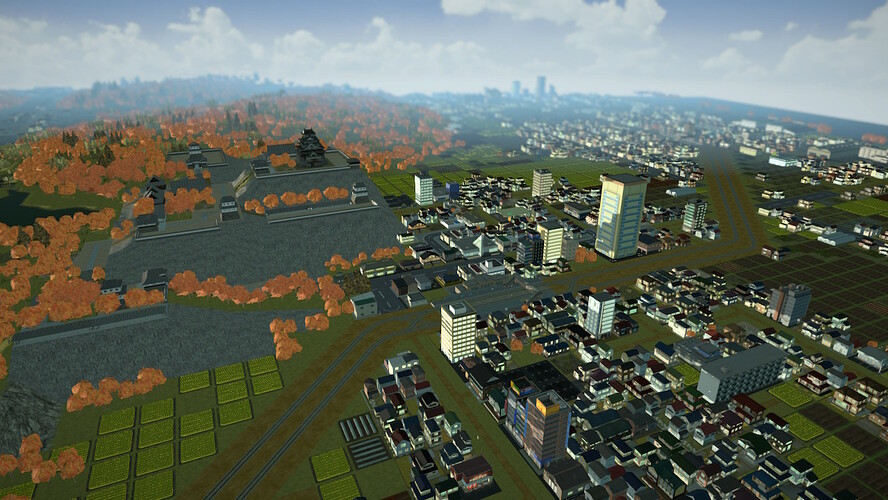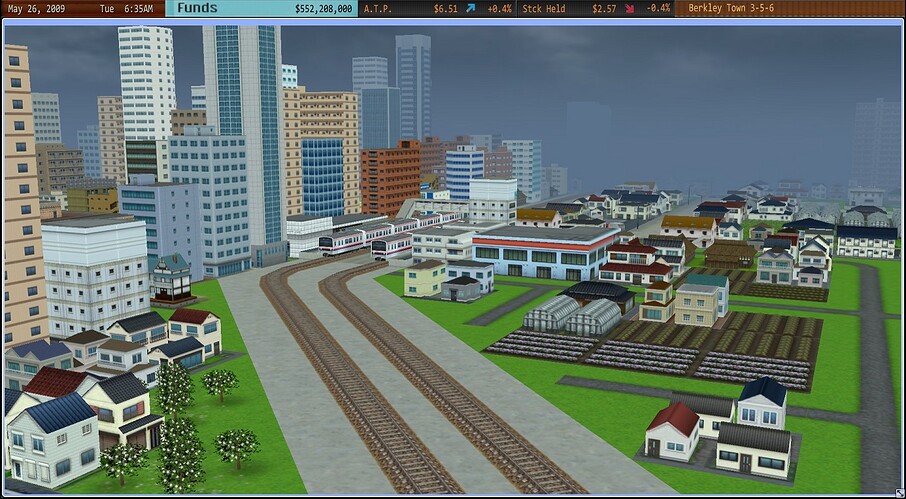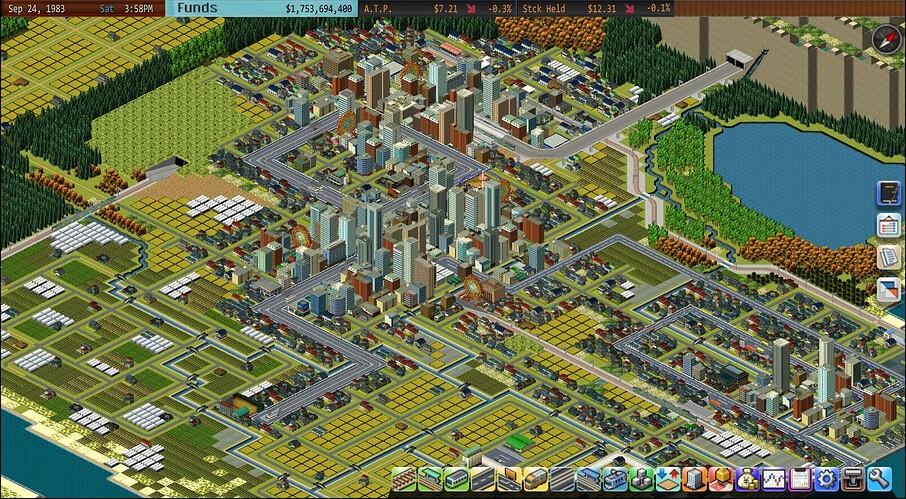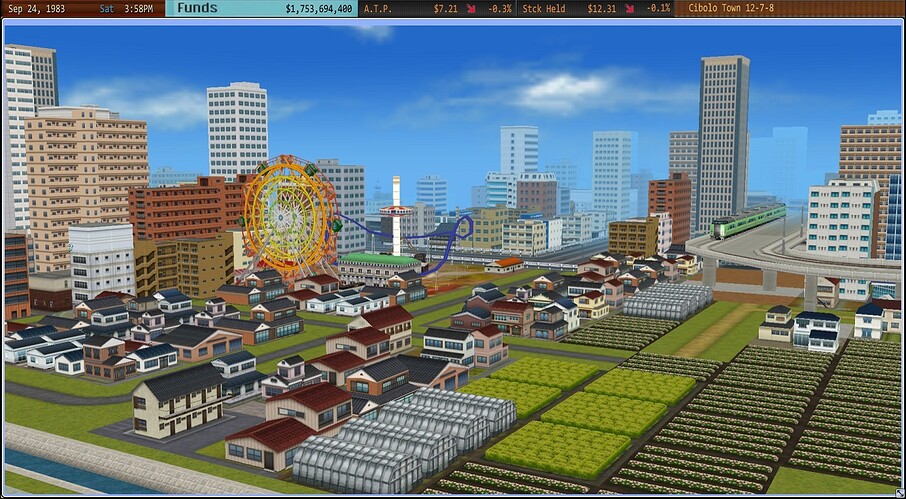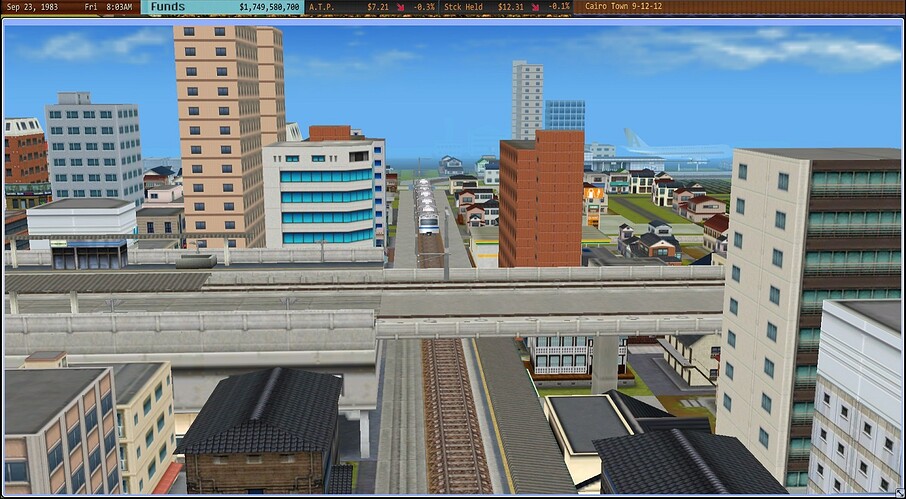Interesting controller releasing in Japan for Switch.
Yeah… not relevant to this game, really, any more than a lightgun would work for an RTS. Still neat though, if you have Densha de Go!! Hashirou Yamanote Sen
Digital Foundry uploaded part one of their massive DF Retro episode on the launch of the original Playstation this weekend. In Japan, A IV Evolution was a launch title for the console and thus DF Retro have a segment on the Playstation version of A-Train 4 in the episode. The A IV Evolution segment begins at the 35:32 mark if the time bookmark doesn’t skip you straight to it.
Well if the price is no object then I would definitely have to give it to All Aboard! Tourism on the Switch, especially as your predominant gaming platform. And as Anonymgeist can attest, it has a certain pick-up-and-play charm to it when using the Switch in handheld mode. Though, obviously, time pressure becomes a bit more pronounced as you move up the difficulty levels and have shorter time frames to accomplish tasks.
Even just the massive quality of life improvement to designating bus and lorry routes is something I would miss returning to PC Classic. Hard to argue with a game which at a minimum retains the same gameplay depth and complexity of the previous release. So far, all the new features appear to serve to only enhance the gameplay experience. Often subtly adding new wrinkles to the strategic considerations and choices on offer.
And thanks to All Aboard! Tourism’s bazillion different ways to go about accomplishing the same thing and optional advanced settings, good strategic planning can minimise the amount of route fiddling required. Leaving you to enjoy the dynamic economic simulation that underlies the entire game, of which there is still much to reveal. I haven’t even touched upon how subsidiaries have different operating/business plans available, which affect operating expenses and sales or resource production.
I grabbed All Board Tourism instead of my plan of getting the PC port of the 3DS version. I blame you, Malkael.
Nah, I can’t blame you: I just tried loading my tutorial demo game into the full game. Not only did it load (I love when games do that), but the full game plays very much smoother than the demo. It’s almost uncomparable. The cursor feels snappy like I wished it always had.
That dated demo is almost doing the game a disservice, at this point.
Time for sleep, but I have been having a good time just browsing around my (am drunken with power, even though I’m driving my company into the ground) town.
Yeah, I really can’t overstate just how amazing a jump the transition from playing the All Aboard! Tourism demo to playing the updated retail game was. The improvements in performance and quality of life improvements that arrived with later patches were pretty noticeable. Not that performance was horrendous or anything in the demo, in handheld mode, but you can’t argue with silky smooth performance and faster loading times.
On a related tangent, looks like Artdink’s latest video is all about construction mode and creating scenarios, with English subtitles available as usual.
Please have your tickets ready for inspection by the conductor and prepare to board today’s train, as our railroading adventure in All Aboard Tourism continues!
Let’s Play All Aboard Tourism - Greasing the wheels of progress…
Click to reveal...
Gradually closing in on our scenario objectives, it is time to grease the wheels of progress as our business adventure in the All Aboard Tourism scenario continues! Today we will be continuing where we left off, which was preparing to acquire a train for our tourist route from Komita, via Nobusu, to Nagashirojo. By the end we’ll have setup a bus route between Komita and Nobusu, turning it into a tourist transfer hub, and built some subsidiaries near Nobusu Station to take advantage of the town’s expected growth.
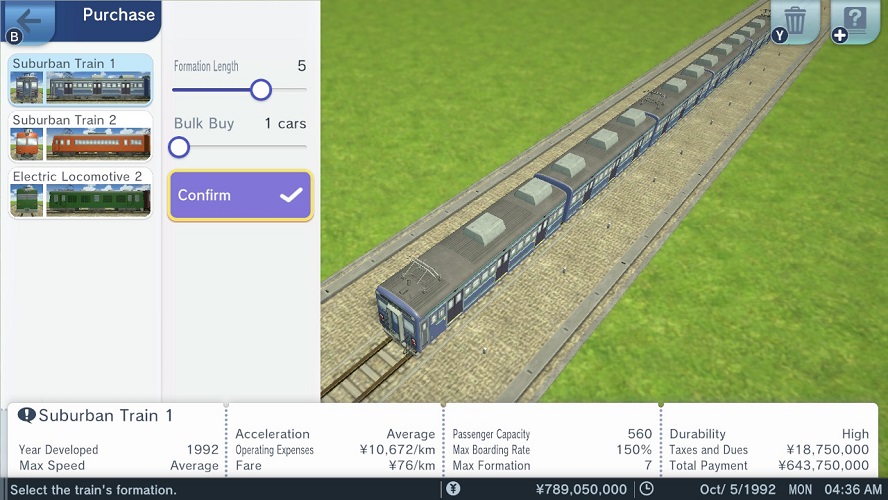
Since Komita is just a mid-sized city compared to the metropolis of Hasuoka we’re going to purchase some new, and better, rolling stock for our Hasuoka-Nagashirojo line. We’ll replace one of our older trains with our new train and then use the older train to provide service on our Nobusu-Nagashirojo line. As demand for our Hasuoka-Nagashirojo services is often outstripping supply the improvements in passenger capacity should be much appreciated.

With the Suburban 2 type train that was operating the 6:30am service from Hasuoka to Nagashirojo replaced with our newly purchased Suburban 1 type train. We’ll now place our freshly withdrawn train near Nobusu station, where it can park up for the night before beginning services from Nobusu to Nagashirojo. Set to depart from Nobusu Station at 7:00am, the service will complete a full loop every two hours and depart five times a day.
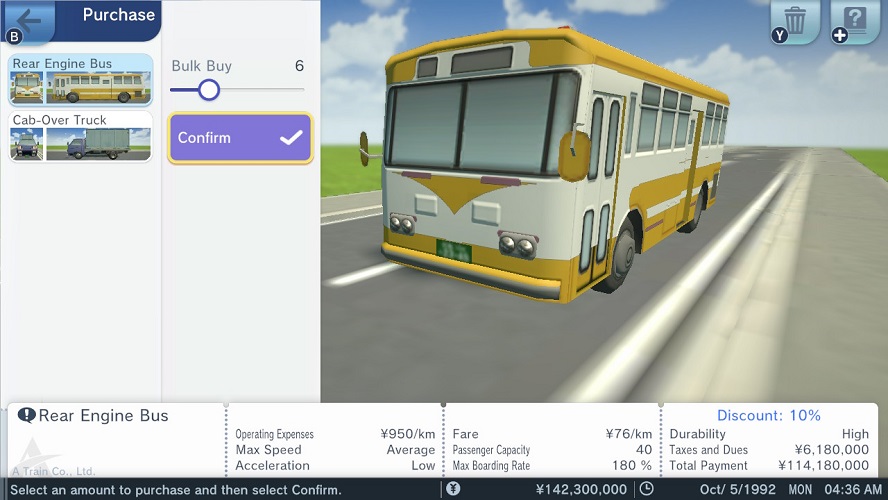
Afterwards, we’ll purchase six buses to begin operating between Komita and Nobusu. This bus service will ensure we now offer a complete tourist route from Komita to Nagashirojo. As previously said, the activity of the tourists in the town of Nobusu as they wait for the connecting train service to Nagashirojo should boost the town’s growth.
Unsurprisingly, comparing and purchasing buses works similarly to trains. Currently, we only have one model of bus available to us but in the future we would be able to compare operating costs, fare per kilometer, and other important statistics when deciding between two or more options.
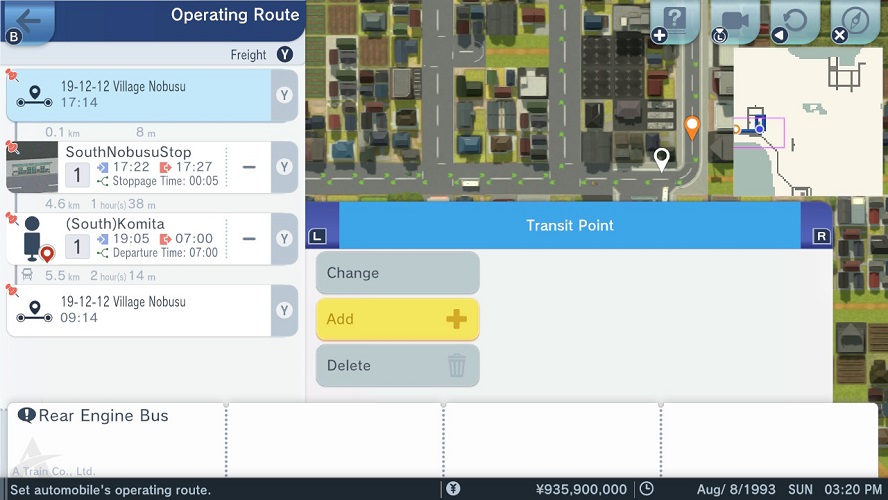
Setting up the operating route of a bus is similar in many ways to the steps we took for our trains. However, one important difference is that road-based vehicles use a waypoint system to guide them. The route a bus will take to reach one waypoint from another is automatically calculated by the vehicle for us. Meaning that we can either let the bus’ automatic navigation do the heavy lifting for us or add in more waypoints if we want to define a more specific path between destinations. It is important to remember that where we place our bus will become a permanent waypoint on its route, which we can use to help define an exact route we want our bus to take.
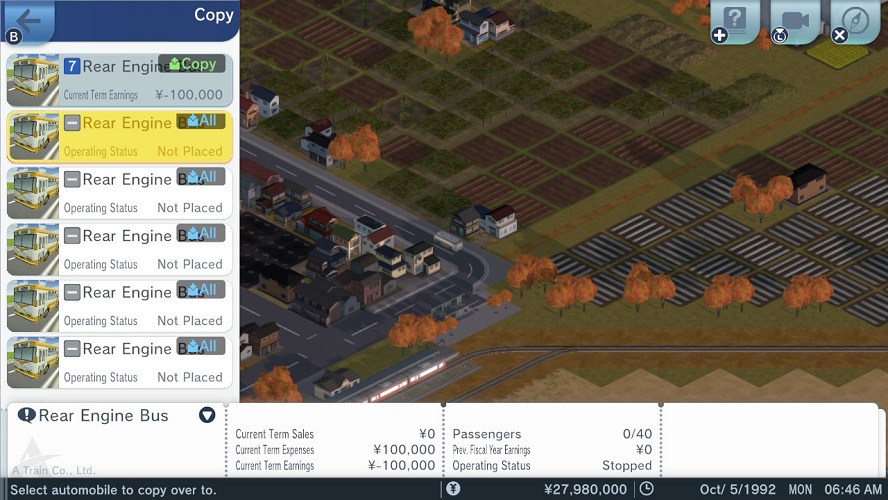
Using the Copy functionality we can minimize the amount of tinkering we need to do with each bus’ operating schedule. After pasting across the settings established for our first bus from here on out we will only need to adjust departure time from Komita and which of Nobusu’s two bus stands each bus will utilise. For this we are going to adopt a simple alternating schedule of odd numbered buses using Stand #1 and even numbered buses using Stand #2. Meanwhile, our first bus will depart from Komita at 6:00am and each subsequent bus will depart 15 minutes later in the morning.

After letting things run for 16 in-game days we begin construction of West Nagashiro Station to connect the local populace of the town, within the Nagashiro district, to our transit network. Subsequently, seven days later on October 28th our newest railway station is constructed and opens for business. As our Nobusu to Nagashirojo service will be passing through our new station during it’s journey West Nagashiro Station has been automatically added to our train’s operating route settings, with a stopping time of five minutes assigned by default.
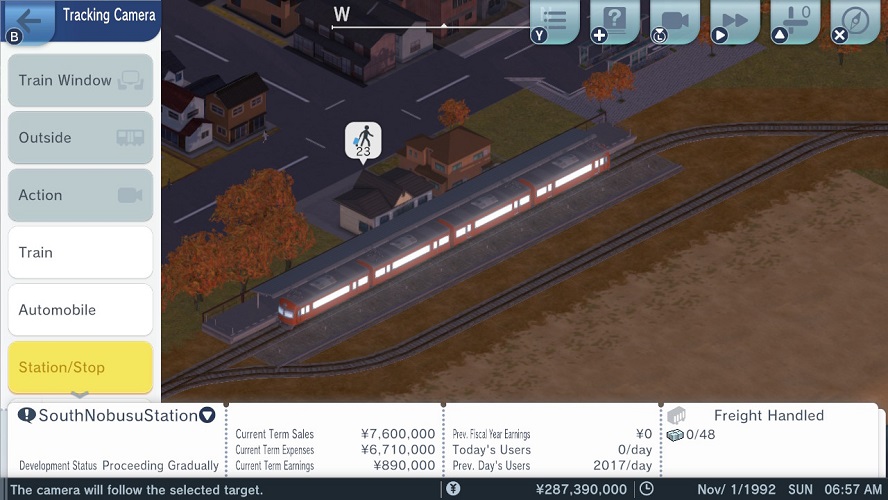

We subsequently step away again for a period of sixteen days to let our company accumulate some more funds. After eight months in operation of the region’s transportation needs now might be a good time to consult our income statement and see how our finances are progressing for this financial year. As we can see from the picture below, we are currently achieving net earnings of 402,530,000 Yen. So, well on our way to hopefully achieving a profit by the end of the financial year once taxes and other expenses have been accounted for.
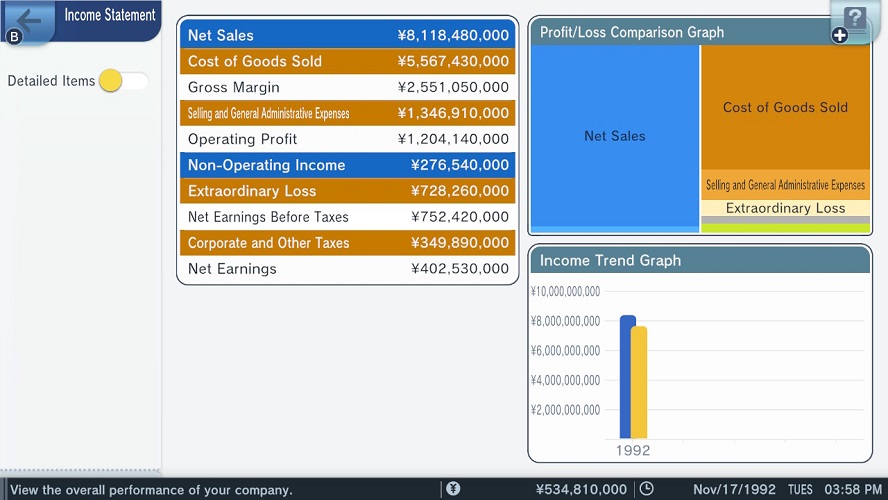
Checking back on our train station and bus stop in Nobusu, we can see that the influx of tourists has elevated the development status up to “Proceeding Gradually” and “Proceeding Well” respectively. Consequently, the Nobusu township is beginning to experience a raft of urban development projects that will boost the population and attractiveness of the township. Never one to turn up an opportunity to generate new sources of revenue, our company will contribute to this wave of development by constructing some subsidiaries near our transit options.

We first begin by constructing a Drive-Through eatery nearby our train station and bus stop, which should be a beneficial symbiosis.

Afterwards we continue our construction spree by building a couple of small housing complexes next door to our bus stop. Which should also prove to be a beneficial symbiosis in the long run.

We then follow that up by constructing a residential apartment block next door to the Nobushu train station. Once again displaying the potential to achieve some good synergy with our nearby transportation stops, by providing potential passengers.
During December 28th we begin the construction of a gas station in Nobushu township and subsequently receive new from our secretary that our company now owns 10 subsidiaries. A number which will only continue to grow over the course of the scenario as we help boost development in the region and push the population to our objective of 20,000 people.

Construction of our gas station is completed on the afternoon of January 8th and swiftly opens for business. Which now allows us to examine another gameplay aspect of the modern A-Train games. Similarly to how we can buy and sell land, we can may also buy and sell subsidiaries on the real estate market. Therefore, if we are strategic in where, when and what subsidiaries we construct our company can generate revenue by becoming a property developer.
Rather than constructing subsidiaries for the longer term operating profits we hope they achieve we can instead develop, or redevelop, land and then sell the newly developed land and associated building\business on the open market. There are two options when choosing to sell a subsidiary, the “Find Buyer” and “Quick Sell” options. The “Quick Sell” option speaks for itself and represents wanting to sell a subsidiary instantly for whatever knockdown price someone will buy it for. Alternatively, the “Find Buyer” option often won’t result in an instant sale, however, it will net us the best price and can often lead to selling our fixed assets for a profit.
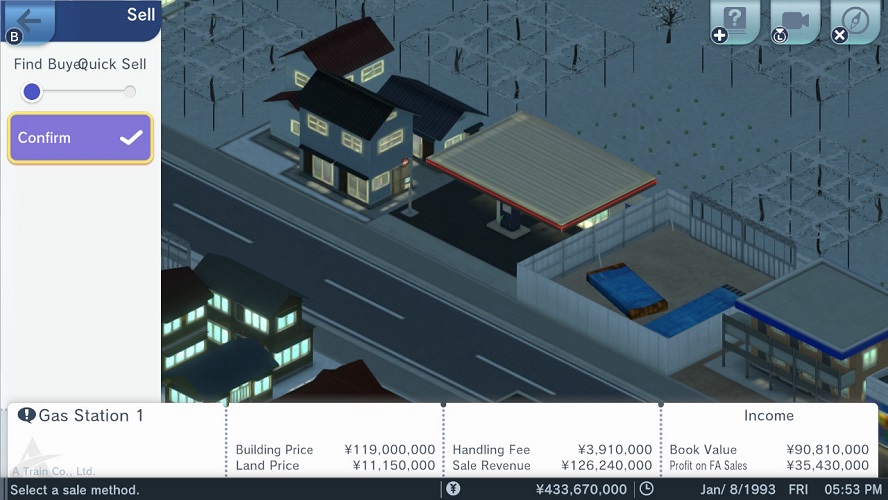
As pictured above, when selling subsidiaries the assessed value of the building and land, and the sales revenue generated are taken into account when deriving the sale price. Of course, any transaction will also incur a handling fee as well. The difference between the book value of the subsidiary to our company and the sale price is the fixed asset profit or loss we will generate selling the subsidiary. This particular strategy can be most beneficial in scenarios with short completion time frames where an instant infusion of Yen is more beneficial to our business plans than a slow, steady influx of revenue.

Taking in the sights of the development that has occurred around Nobushu township, we conclude the chronicling of our business adventures for now. I do hope you can join me next time as we make one final push to reach our completion conditions for the scenario. Where we will usher in a new financial year, see how we performed for the current financial year, discuss taxes and tax payments, discuss shareholder confidence, pay out our first ever dividend to our private shareholders, and more.
Until the next time we met aboard the A-Train, I hope you have a safe and enjoyable journey!
Final entry for my Let’s Play of the opening scenario of A-Train: All Aboard! Tourism today since we’re close to hitting all our completion conditions. Taking suggestions if there is anything anyone wants to see in the future. Whether that be from this game or one of the other games in the series, such as A-Train PC Classic or A-Train 9 on the PC. If it is a continuation of A-Train: All Aboard! Tourism could either move on to the next scenario, which has different completion conditions, or do some focused gameplay mechanic deep dives.
One such systems interaction I didn’t yet touch upon was the ability to increase and decrease fares in 10% increments. Consequently, influencing the affordability and consequently ridership of your transportation services. Ultimately, neatly tying into the Public Transportation Utilization Rate parameter that I have broached previously. Which both also interact with the Seasonal Tour marketing plans that you can enact to boost the number of passengers riding your services on weekends and holidays.
Please have your tickets ready for inspection by the conductor and prepare to board today’s train, as our railroading adventure in All Aboard Tourism concludes!
Let’s Play All Aboard Tourism - Steaming towards victory…
Click to reveal...
Nearing the completion conditions of the scenario, the time has come for the finale to Let’s Play All Aboard Tourism. Today’s finale is all about consolidating our funds for tax season, promptly doing it all over again so we can pay out stock dividends to retain shareholder confidence, and aiding the region to reach 20,000 inhabitants via the construction of more residential subsidiaries. So, without further ado, let’s get straight into it!
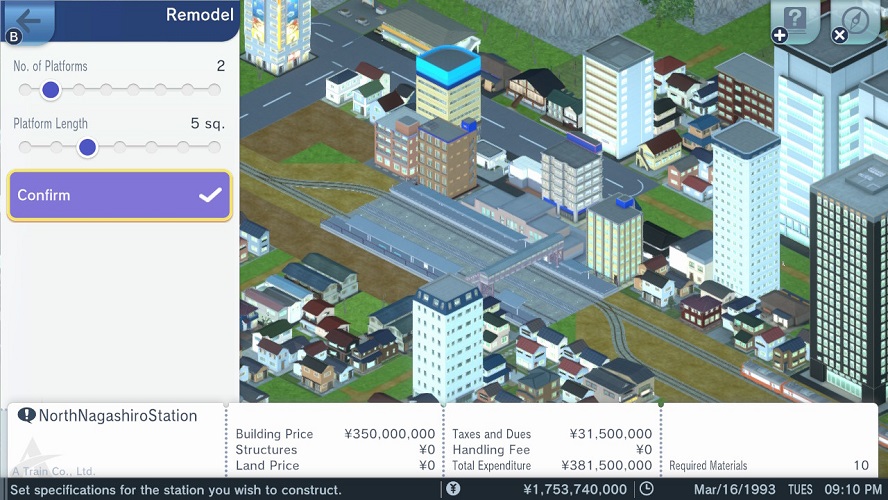
With a comfortable buffer of 1,753,740,000 Yen in our company’s coffers the first thing on our agenda is the redevelopment of Nagashirojo Station. Today we are going to expand the station building so that it can house more facilities. Which should in turn improve the sales and advertising revenue our station can generate per day, thanks to the heavy foot traffic frequenting the area. The total cost of the station redevelopment will encompass the price of the building works plus taxes and dues, totaling 381,500,000 Yen.
Unlike with constructing a new station, a redeveloped station is still able to operate during the (re)construction phase. Therefore, passengers will still be able to both board and depart trains that service the station. Making it a fairly straight forwards decision for our company compared to if the station shutdown during redevelopment works, since it would impact our tourist routes and ridership.
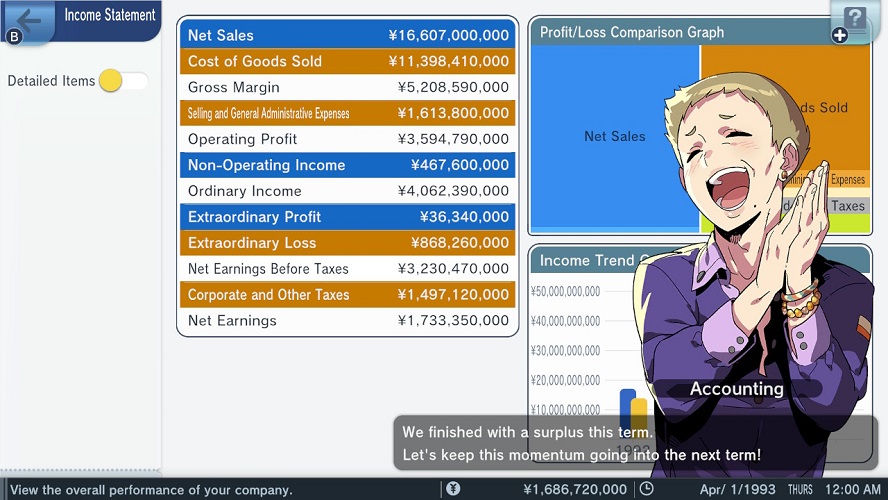
Come midnight of April 1st, 1993 and our accounting manager delivers us the company’s finalised income statement for the financial year, which spanned from April 1st, 1992 through to March 31st, 1993. The detailed items view was too lengthy to fit into just one screenshot, so the simple view shall have to suffice this time. Browsing through the income statement we can see that our company managed to post a healthy post-tax income of 1,733,350,000 Yen by the end of the financial year.
Consequently, we can expect a rather large corporate tax bill of at least 1,497,120,000 Yen to be handed to us. The corporate tax rate on our company’s profits varies in A-Train: All Aboard! Tourism depending on the time frame of the scenario, reflecting the historical tax policy of the period. If we are unaware what the corporate tax rate for the period might be then planning for a corporate tax rate of 50% is a good conservative starting point. A little bit of math shows us that this 50% figure is indeed, approximately, the Japanese corporate tax rate for the 1990’s time frame of the scenario.
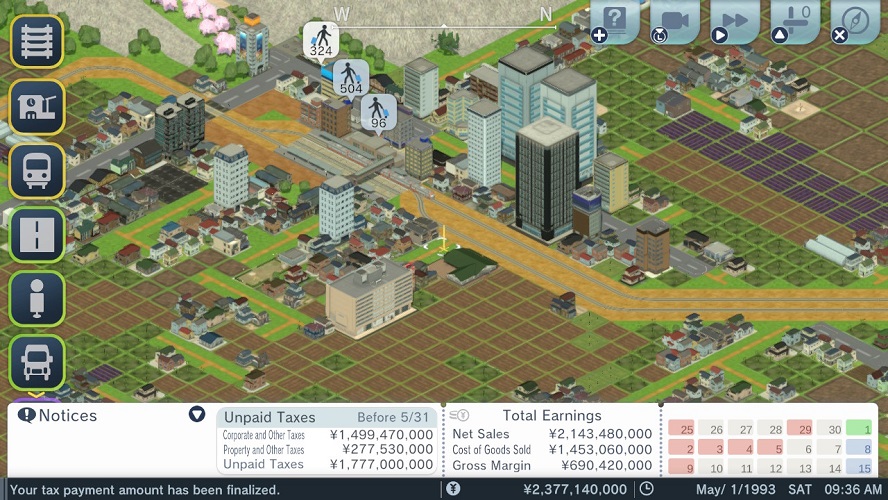
Our total tax bill for the financial year is a combination of corporate, property and other taxes and must be paid in full by the 31st of May. We can either do this ourselves before the due date or the game will handle it for us, as long as we have sufficient funds, during the end of May.
Since tax commitments such as corporate and property tax are typically assessed at the end of the financial year, there are steps one can take to reduce their company’s tax bill ahead of time. In our case though we can easily cover our tax commitments and have plans earmarked for currently owned land and properties. Thus, we did not attempt to reduce our property tax by selling off some of our fixed assets before the assessment date.
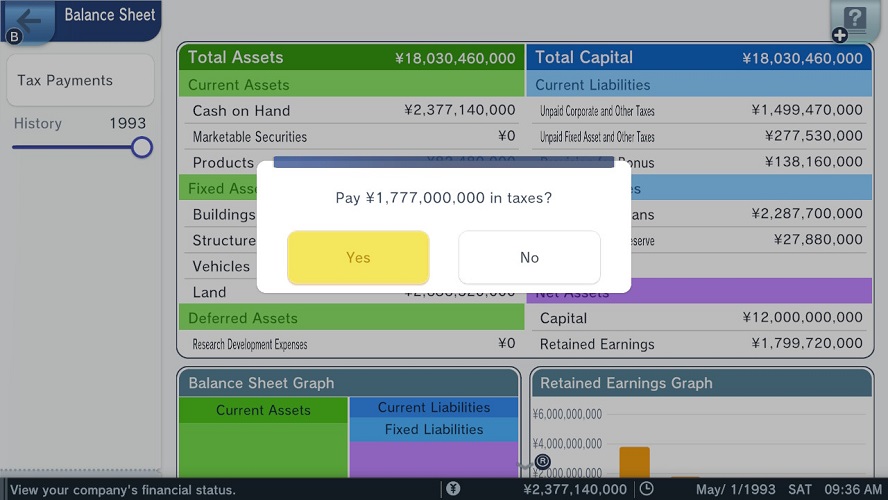
Paying our company’s taxes ahead of time is as simple as accessing the Balance Sheet screen within the Reports screen. Which we can also quickly access using the down button on the d-pad when the game prompts us about our unpaid taxes. With over two billion Yen amassed in our company’s bank account we decide to service our tax commitments ahead of time at the start of May.
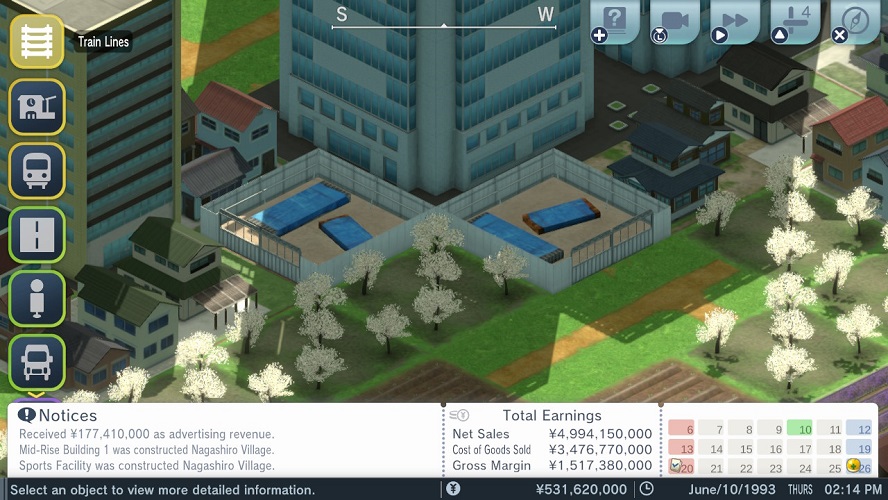
After letting time pass for approximately a month to amass some capital our company decides to construct two new residential apartments in the township of Nagashirojo. These will help bolster the population and foster further urban development in the area. The number of newly constructed commercial buildings in the local vicinity should achieve a great synergy, according to our sales advisor at least.

And here our our two new subsidiaries upon the completion of their construction. As you can see the AI has decided to follow suit and construct a large (2x1) residential apartment block next door as well. In A-Train: All Aboard! Tourism subsidiaries, ergo buildings, owned by us are accented with our company’s colour. Which in this case is currently a deep blue for this scenario, since that is what colour we chose way back at the beginning of the game. In contrast, buildings owned by the game’s AI, representing entities such as private developers, are typically accented with a brown colour.
Afterwards, we let the game freely pass time so that we can swell our bank account ahead the important date of July 1st. Annually upon this date we will be expected by our shareholders to pay out a dividend of at least three percent to maintain their confidence in us as CEO. Our ability to pay a dividend depends on a figure known as Retained Earnings, which in very basic layman’s terms could be considered the historical accumulation of our past net profits and\or losses for past financial years. Thus, we must strive to keep our company’s retained earnings figure in the black. Which is most easily achieved by consistently reporting a net profit each financial year.
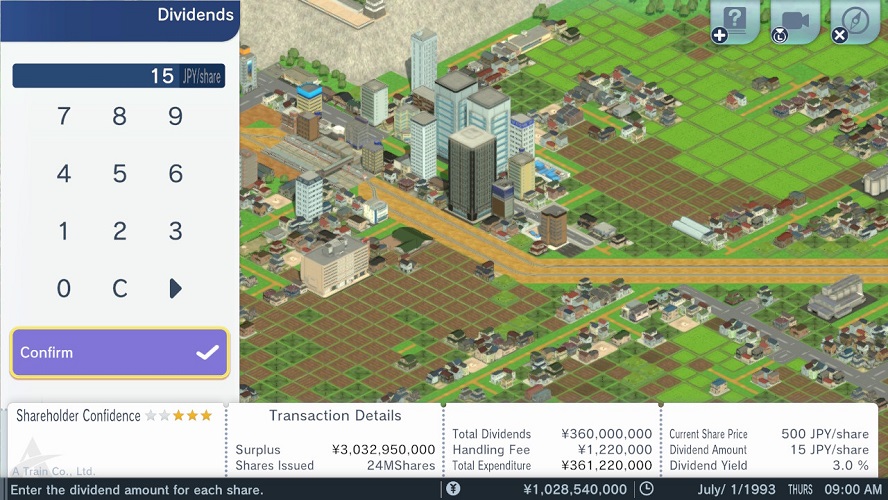
When playing on Normal difficulty or higher Shareholder Confidence is an important parameter to keep track of. Similar to other games like Railroad Tycoon, the shareholders can attempt to replace us as CEO should their confidence hit a crisis point. In A-Train: All Aboard! Tourism this crisis point is typically upon reaching zero stars in shareholder confidence. Which consequently would then signal game over for us.
The Dividends menu provides us with an informative breakdown of all the information we could possible need to know when deciding upon a figure. With the dividend yield arguably being the most important of the bunch to pay attention to when deciding upon what sort of dividend to pay out to shareholders. We can see that our company currently has 24 million shares held privately and thus a figure of 15 Yen per share, hitting that 3% yield threshold, will result in the company paying out a total of 360,000,000 Yen to our shareholders, before any handling fees are also applied.
Subsequently, shareholder confidence has now increased by one whole star. This brings our shareholder confidence rating up to four stars out of five, from a previous rating of three stars. Securing our position as CEO of the company for the foreseeable future.
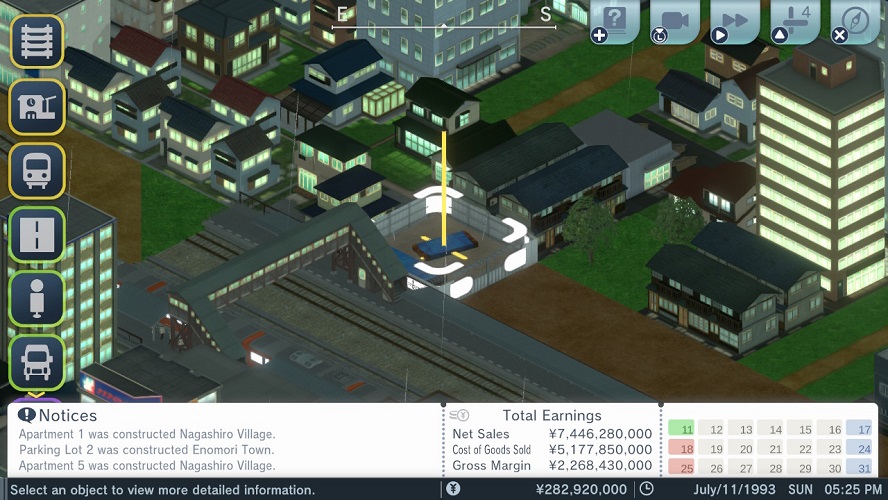
Closing in on meeting our last completion condition, as the region’s population nears 20,000 people, we decide to build another residential apartment block in Nagashirojo. This time we are going to build this subsidiary next to our station on land that our company already possesses. The construction of this residential apartment block should either push us over the finishing, or go very close to doing so.

Upon the construction of our latest subsidiary being completed during the 8th of August, we receive news from our secretary that we have finally fulfilled our second completion condition. The number of inhabitants in the region as a whole has now crossed over the 20,000 person threshold. Thus, we have now achieved both of our completion conditions and have obtained victory in the All Aboard Tourism scenario!
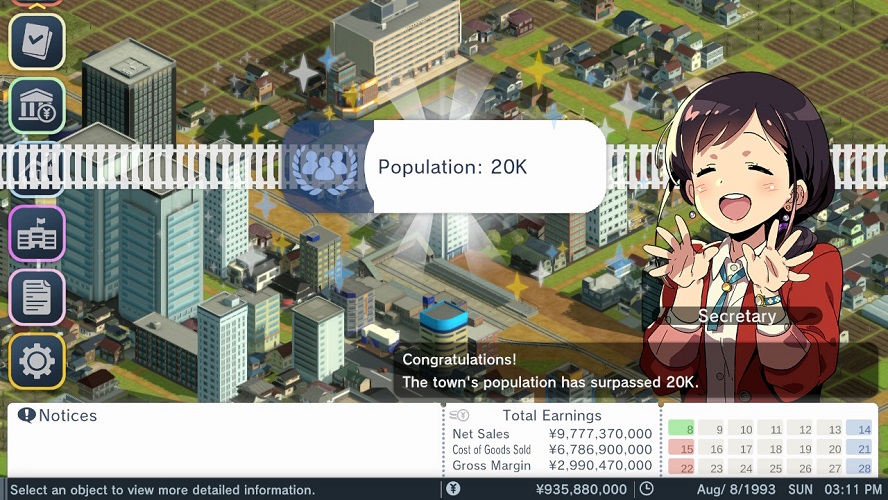
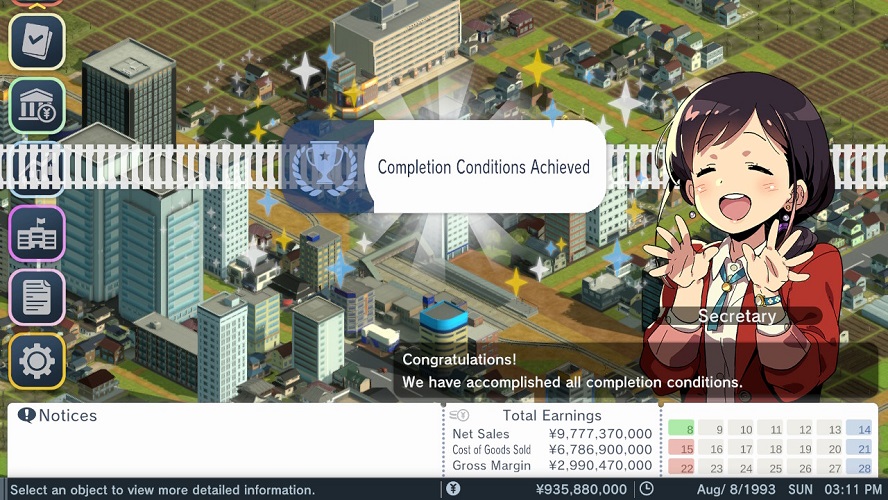
Subsequently, we have now upgraded the trophy besides the All Aboard Tourism scenario from a bronze trophy to a silver trophy. Proving that we have the business skills required to successfully navigate our way through the increased challenge, depth, and complexity that Normal difficulty (and above) offers.

That concludes our finale to Let’s Play All Aboard Tourism. I hope you have enjoyed the journey as we took a fledgling transportation network and gradually expanded it to bring countless tourists to Nagashirojo Castle. Along the way we established a profitable private railway corporation, helped the region to develop in multiple areas, and saw the population explode past 20,000 inhabitants. To commemorate our success lets take one last screenshot, looking northwards from Nagashirojo towards the now sprawling urban centers of Tomoto and Enomori.
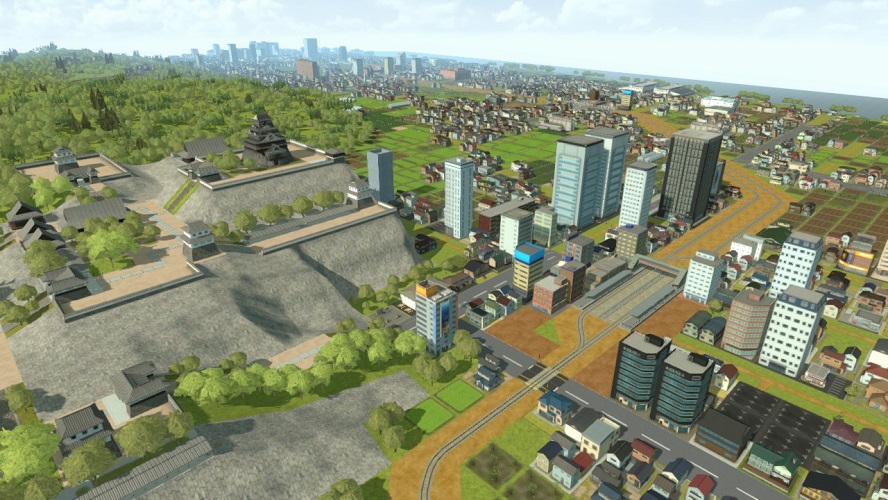
Until the next time we met aboard the A-Train, I hope you have a safe and wonderful journey. Sayōnara!
Could you do something fast for Classic, no need to go into full detail, just something to help the new players get their bearings?
I wonder if the general concepts don’t simply apply between Tourism and Classic?
For a different comparison, I have spent a bit of time with the opening scenario of this version, and the difference between the DS (not 3DS) game and this one are overwhelming. The DS game almost feels like an oversimplified tutorial (I won’t say “a puzzle game”) compared to the crazy involvement of this version. Involved, but also laid back: I spent so much time just looking around my little sandbox and enjoying the passing of time, watching its now very organical growth (I haven’t kept tab on the city builder genre, but I’ve never seen a game reproduce the pulsating beats of a human colony that well — it is probably helped by the very unique aspects of the Japanese ones).
I’ve been fiddling around the train scheduling and its idiosyncracies, and it is one aspect that was absolutely confusing at first, but is now becoming my favourite part of the game.
Actually, scratch that, I love all parts of the game. All the elements are so intertwined and rewarding thought on the long run. The game feels like it really evolved from the puzzle aspects of the DS game into the city building strategy game with antfarm voyeurism I have longed for since Sim City. The attention paid to the passing of seasons and the rhythm it creates in particular is such an integral part (some would say trope) of Japanese life, and the game captures it perfectly, amongst so many other more detailed things.
Learning the interface was a bit of pain. But I want to really thank you, @Malkael, for rooting and pushing for it and making me revisit it, then purchase it. The little warming joy of booting up my city, be it in my chair or in my bed, is something very few games managed to ever make me feel.
Oh, I was rambling on, and I forgot to post the picture of my not so developed city. But I prefer countrysides to downtowns!
Well thanks to the dedication of someone else who played and enjoyed A-Train PC Classic I can even do you one better. How about a well-structured, comprehensive Tips & Tricks guide, hosted on Google Docs, for the game? Should provide a good fundamental base for anyone to get to grips with the game and begin enjoying it.
Then from there people can figure out how much complexity they want to tackle with their routes and such. Since I would likely have a different take on advice for single track lines due to having a stronger grasp on the minutiae of train timetabling (i.e., co-ordinating multiple train schedules) and how to utilise signal blocks (i.e., Signal Stations).
Thanks.
Indeed, A-Train 3DS // PC Classic and A-Train: All Aboard! Tourism really know how to nail some antfarm voyeurism. Or as internet translation services often call it when I get them to crudely translate interviews and stuff from Japanese into English, it really nails that feeling of being a “Garden Box City”. It’s part of the reason why these games include a 3D mode and a smorgasbord of cosmetic customisation options, as it really feeds into that whole antfarm (garden box city) appeal that hooks many people.
Yeah, the general principles are fairly cross-applicable between the two games. Usually the minutiae where things begin to differ between the two games in important ways. A prime example being construction materials, you are not required to supply them in All Aboard! Tourism for anything to build itself but you will need to supply them in PC Classic for stuff to build itself.
Since I went back to A-Train PC Classic for several hours, sounds like the good excuse to share some screenshots from a couple of my scenario playthroughs.
Scenario #1: Take the A-Train!
Scenario #3: On Track to Tomorrow
I have just been introduced to a shortcut that hadn’t been unlocked or documented till now: pressing R switches between important items (it was actually a liability for me, as I often was pressing it instead of Zr), and pressing Y is a shortcut to managing them directly.
Why keep that away from the player for so long :O
I must say I’ve grown fonder and fonder of the visuals of Tourism. I liked the cold isometric feel of the original game (it’s an identity to which the earlier Shin Megami Tensei owes much too), but everything is so much more… lively in the new game. Might be simply due to direct lightings.
Ah, also @jpinard, if you haven’t checked those games out, and especially the newer one for which a demo is available on your Switch, get onto it once you’re done building the perfect Animal Island ;D
Got the demo. Thank you! You know me so well. :)
Tackling a multiple year scenario sure does allow a metropolis to gradually form over time. Ended up with a total population of over 50,000 people by the time I ticked off all the completion conditions for the second scenario, City of Hopes & Dreams.
A great scenario for showing off just how powerful well integrated subsidiaries can be. Had a Theme Park generating profits of several billion Yen each financial year thanks to great transportation links. Being able to pour tourists into a company-owned resort area, a combination of different subsidiaries types, confirmed a real money spinner.

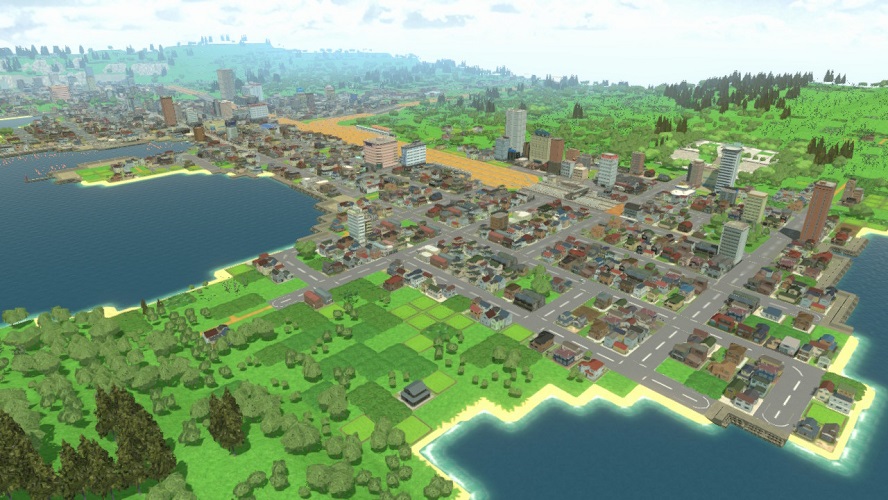
After reading Tom’s recent top 10 list and then finding this thread, I’ve accidentally sunk 5 hours into a train management sim on the Switch. I’m having a blast micromanaging train schedules. I didn’t see that coming, but thanks @Malkael for the infectious enthusiasm!
Decided to let one of my save games run on the Fast Forward speed for a while and observe how things would naturally develop. Just a casual bit of urban sprawl going on as the population grows, with areas of condensed density sprouting up nearby to stations as well.
Meanwhile, Artdink released Patch v1.1.1 for A-Train: All Aboard! Tourism earlier in the week. It’s primarily focused on fixing up bugs that either still existed in the game or that were introduced with the large v1.1.0 update. Could just be a placebo effect but I feel like some of their bug fixes had a positive knock-on effects on the game’s overall technical performance too, such as quicker save times.
Patch v1.1.1 Changelog
[Added functions]
- Added aviation obstacle lights to chimneys, station buildings, and harp bridges.
- When two trains are trying to enter a station at the same time, they will now be able to enter the station platform at the same time if the train interval is set to 0.
[Bug fixes]
- Fixed a bug that caused the save safety process to fail.
- Signal stations could not be built on an elevated track.
- In the return journey of a tourist route, if there was a station just before a neighboring town that does not have passenger service and was not on the return sightseeing route, the sightseeing route would be lost.
- The accounting process for purchasing resources from neighboring towns by freight train was wrong.
- When copying a train operation plan, if the destination of the copy went off the screen, the copy status would become “Name” when it was displayed on the screen again.
- When copying a train operation plan, the target could not be selected for each slot with the number 9.
- The estimated arrival time of the station in the train operation plan was off by 20 seconds for each stop.
- If a road was on a paved slope, a building could be built on it.
- When a T-junction and an exit of a multilevel intersection were adjacent to each other, buses would overlap.
- When constructing a building on the beach, there will no longer be supports in the sea.
If the software is unstable when saving, we have taken measures to complete the save on priority.
In this case, a dialog will appear. Please restart the software once.
Welcome aboard the A-Train! Glad to hear you are having a blast with it so far, long may it continue.
Once I have a bit more free time on my hands again I have some ideas I want to try enthusiastically experimenting with.
It’s an aspect I didn’t enjoy in previous iterations I played but that I find strangely rewarding in this one. The awkward interface makes it somewhat funny to actually handle. Game brewing fun out of frustration!




